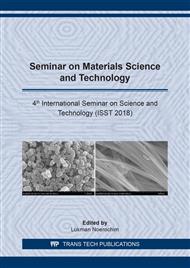p.228
p.234
p.240
p.246
p.251
p.257
p.263
p.270
p.280
Prediction of the Density & Thermal Conductivity of Light Bricks on the Effect of Aluminium Elements Using Artificial Neural Network (ANN)
Abstract:
Indonesia with abundant limestone raw materials, lightweight brick is the most important component in building construction, so it needs a light brick product that qualifies in thermal, mechanical and acoustic properties. In this paper raised the lightweight brick domains that qualify on the properties of thermal conductivity as building wall components.The advantage of low light density brick (500-650 kg/m3), more economical, suitable for high rise building can reduce the weight of 30-40% in compared to conventional brick (clay brick). To obtain AAC type lightweight brick product that qualifies for low thermal and density properties to the effect of Aluminum (Al) additive element variation using artificial neural network (ANN). The composition of the main elements of lightweight brick O (29-45 % wt), Si (25-35% wt) and Ca (20-40 % wt). Mixing ratio of the main element of light brick (Ca, O and Si) with Aluminum additive element (Al), is done by simulation method of artificial neural network (ANN), Al additive element as a porosity regulator is formed. The simulation of thermal conductivity to the influence of main element variation: Ca (22-32 % wt), Si (12-33 % wt). Simulation of thermal conductivity to effect of additive Al variation (1-7 % wt). Simulation of thermal conductivity to density variation (500-1200 kg/m3). The simulated results of four AAC brick samples showed the thermal conductivity (0.145-0.192 W/m.K) to the influence of qualified Aluminum additives (2.10-6.75 % wt). Additive Al the higher the lower density value (higher porosity) additive Al smaller than 2.10 % wt does not meet the requirements in the simulation.Thermal conductivity of AAC light brick sample (0.184 W/m.K) the influence of the main elements that qualify Ca (20.32-30.35 % wt) and Si (26.57 % wt). Simulation of artificial neural network (ANN) of light brick shows that maximum allowable Si content of 26.57 % wt, Ca content is in the range 20.32-30.35 % wt, and the minimum content of aluminum in brick is light at 2.10 % wt. ANN tests performed to predict the thermal conductivity of light brick samples obtained results of the average AAC light brick thermal conductivity of 0.151 W/m.K. The best performance with Artificial Neural Network (ANN) characteristics has a validation MSE of 0.002252.
Info:
Periodical:
Pages:
270-279
Citation:
Online since:
July 2019
Authors:
Keywords:
Price:
Сopyright:
© 2019 Trans Tech Publications Ltd. All Rights Reserved
Share:
Citation:


